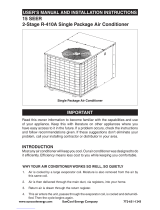
6
4. INSTALL THE RETURN AND SUPPLY AIR
FITTINGS ON THE UNIT
The supply and return fittings are included with
select models. If supplied, the duct fittings are
shipped in the supply duct. They attach to the unit
openings with a flange and bead arrangement,
secured with two sheet metal screws. Note: For
ease of access, install fitting before positioning
unit in final location.
SUPPLY DUCT
Position the supply duct collar, if supplied, so the
edge of the unit opening fits between the flange
and the bead. Overlap the collar ends keeping the
small screw holes underneath. Align the holes in
the crimped area and install one screw.
Note: It may be necessary to loosen the four
screws that hold the transition duct in order to
install the supply fitting. Re-tighten when instal-
lation is complete.
Tap collar as necessary to ensure engagement
with unit opening and install second screw.
Tighten first screw. Rotate collar clockwise so
joint is near three o’clock position.
RETURN DUCT
Align the 14” return duct slots with the holes in
the collar and install two screws. Position the
collar over the opening and align the four notches
in the collar with the four dimples in the panel.
Using self-drilling screws (10-16x.5) attach the
collar to the rear panel.
5. LOCATING AND INSTALLING THE RE-
TURN AIR ASSEMBLY
To avoid complications, locate and install the
return air assembly first. The return air box
with grille and filter (Figure 4) should not be
located in heavy traffic areas like hallways or
center of rooms. A good spot is in a corner or
under a table, if a minimum two inch clearance
is available. If desired, the return opening can
be located inside a closet with louvered doors
that have an open area equal to or greater than
the 12” x 20” grille furnished. The return air grille
can be placed in the wall of a closet and the air
ducted into the filter box through a boxed-in area
at the closet floor level. Make sure the filter is
readily accessible.
After determining the location of the return air
opening, start the installation from under the
home by cutting a small hole in the fiber under-
board to determine how the floor joist location
will affect cutting the opening needed for the box.
Floor joists generally are located on 16” centers,
leaving 14-3/8” between joists. After measuring
the return air box (approximately 12-1/4” x 14-
1/4”), cut the hole through the floor so that the
box will fit between the floor joists. Care should
be taken when cutting through carpeting to avoid
snags. In most installations it will be necessary to
cut a similar hole in the fiberboard directly under
the hole in the floor. However, if the floor is more
than ten inches deep, it will only be necessary
to cut a hole for the collar on the return air box
or for the insulated duct.
Set the box into the opening and fasten with
screws or nails. Put the filter and return air
grille in place.
6. LOCATING AND INSTALLING THE
SUPPLY DAMPER(S)
CAUTION:
When a home is not equipped with a
make-ready kit, means must be pro-
vided to prevent simultaneous opera-
tion of the heating and cooling units.
A heat/cool thermostat is available for
this purpose.
When installing this air conditioning
system in conjunction with a furnace, a
damper must be installed in the furnace
base assembly to prevent cold air being
discharged around the heat exchanger.
Damage to the heat exchanger and
asphyxiation may occur if a damper is
not installed.
Check with the furnace manufacturer
for damper requirements. Failure to
install the required furnace damper
may invalidate code agency listing and
limited warranty on the furnace.
When locating the supply damper(s), carefully
check floor joists and frame members that could
interfere with the installation of the damper or
flexible duct. Ideally, the damper should be
Figure 5. Supply Damper
















